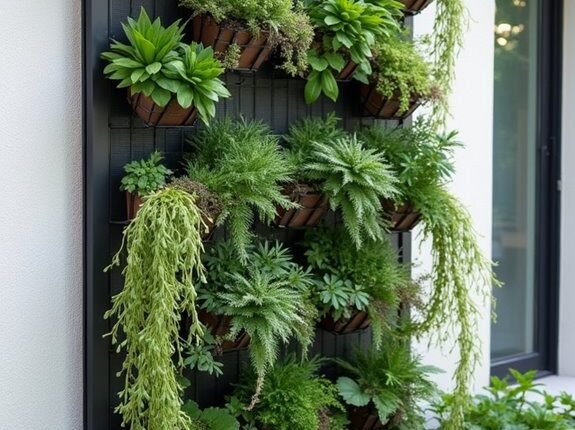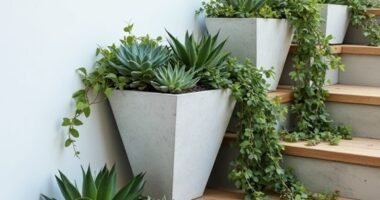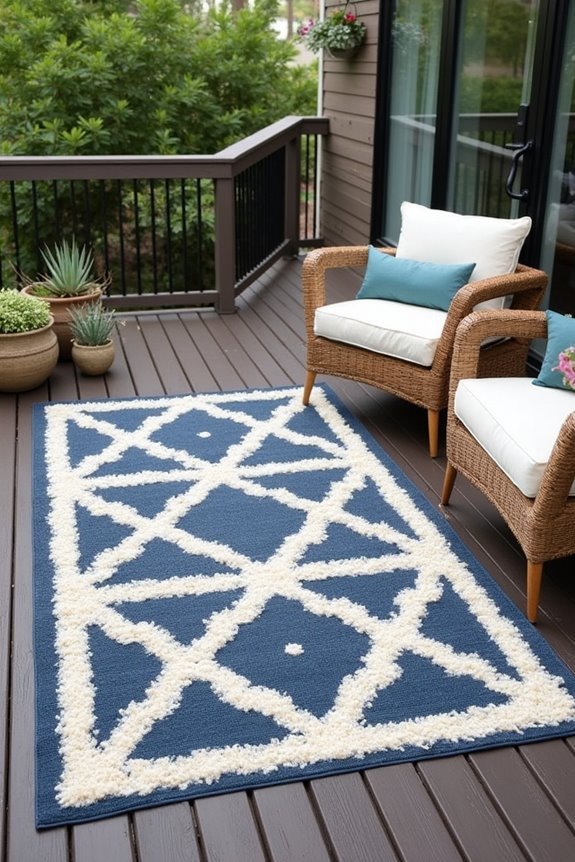You’ll love transforming your small outdoor space with vertical gardening options! Try pallet wall gardens for herbs, hanging pocket planters for cascading flowers, or fence-mounted boxes to create living walls. Repurposed rain gutters, tiered planters, and mason jar herb gardens add charm while saving space. Self-watering bottle systems and balcony railing displays make maintenance easy. These space-saving solutions bring greenery to even the tiniest areas, with plenty of creative possibilities waiting to be explored.
Key Takeaways
- Tiered and stackable planters maximize vertical growing space while providing different levels for various plant types.
- Wall-mounted options like pallet gardens, fence boxes, and living picture frames transform vertical surfaces into growing areas.
- Repurposed materials such as rain gutters and wooden ladders create affordable and customizable vertical gardening solutions.
- Hanging systems including pocket planters and mason jar herb gardens utilize overhead spaces without taking up floor area.
- Vertical hydroponic systems enable soil-free growing with efficient water usage for leafy greens and herbs.
Pallet Wall Gardens for Herbs and Succulents

Wooden pallets, with their rustic charm and practical design, offer an incredible foundation for vertical gardening when space is limited. You’ll love how these versatile structures transform into living walls of greenery that don’t take up precious floor space. To create your own pallet garden, simply sand rough edges, add landscape fabric as backing, and fill each slat with nutrient-rich soil. DIY vertical planters can maximize growing space while adding a cozy, natural aesthetic to any outdoor area. Herbs like basil, mint, and thyme thrive in the upper rows where they’ll get plenty of sunlight, while succulents work beautifully in the lower sections. You can paint your pallet to match your outdoor decor or leave it natural for that farmhouse feel. The best part? Your vertical herb garden keeps cooking ingredients within arm’s reach while adding a stunning green focal point to your small space. These compact solutions are perfect for urban balconies and petite patios where traditional gardening isn’t feasible. Creating a hanging garden system with your pallet allows for better air circulation and easier maintenance of your plants.
Hanging Pocket Planters for Trailing Plants
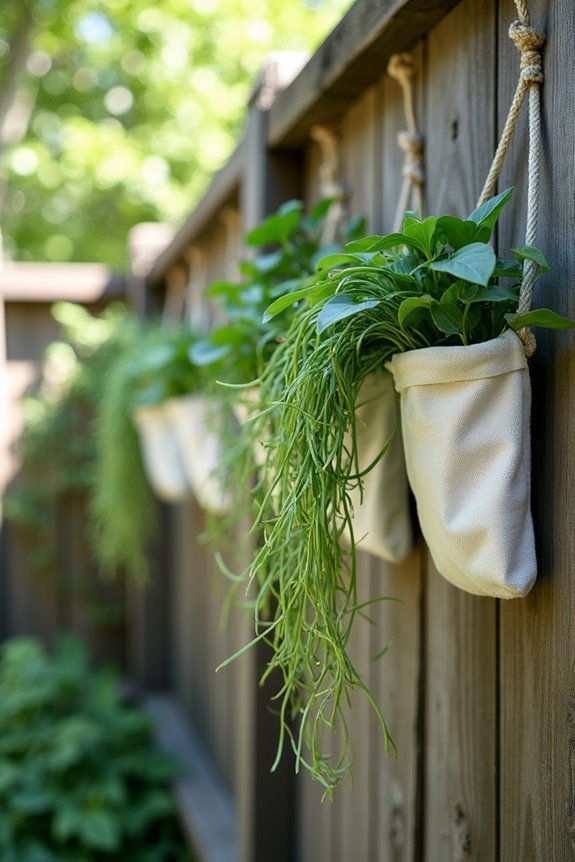
While pallet gardens maximize vertical wall space, hanging pocket planters offer another dimension to your small garden by utilizing overhead areas. These fabric or plastic organizers create a cascading effect as your plants spill over the edges, adding movement and life to your space. You’ll love how they transform an ordinary balcony or patio into a lush retreat! Adding creative garden art between your planters can create eye-catching focal points that enhance your outdoor sanctuary.
Here’s why pocket planters are perfect for trailing plants:
- They’re lightweight and won’t strain ceiling hooks or railings
- Multiple pockets allow you to mix different varieties for visual interest
- The vertical arrangement creates natural irrigation as water trickles down
- They’re easy to reposition as seasons change, giving you flexibility
Vertical wall planting systems offer innovative solutions for maximizing limited outdoor space. Remember to choose trailing varieties like pothos, ivy, or creeping Jenny for the best cascading effect. For added comfort while enjoying your vertical garden, incorporate weather-resistant pillows to create cozy seating areas beneath your hanging displays.
Repurposed Rain Gutter Planters
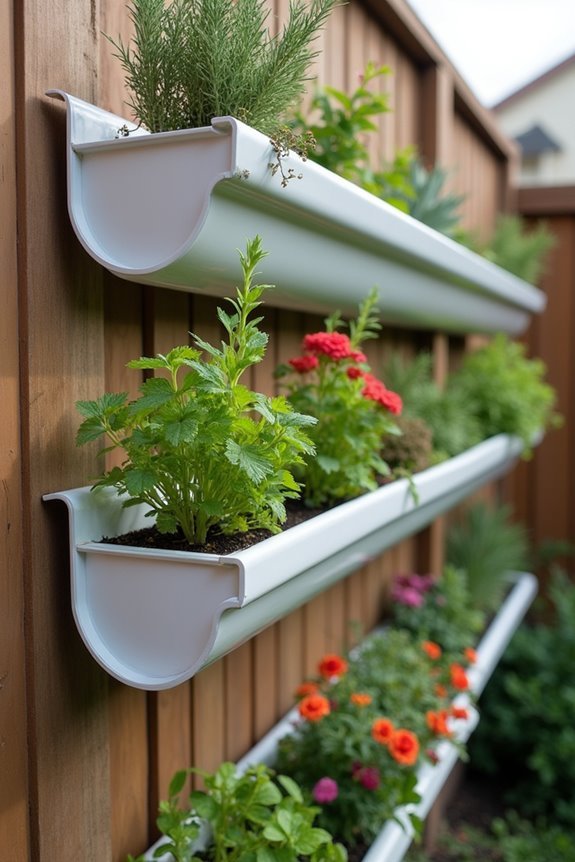
When affordable materials meet creative gardening, repurposed rain gutters become surprisingly elegant planters for your small outdoor space. They’re perfect for growing herbs, strawberries, and small flowering plants in a horizontal row while taking advantage of vertical wall space. Consider exploring upcycled planter options to maximize your eco-friendly garden design. For enhanced privacy, position your gutter planters to create natural green screens along exposed areas. Transform your small balcony space into a charming vertical oasis with these versatile DIY planters.
| Plant Type | Gutter Depth | Watering Needs | Best Location |
|---|---|---|---|
| Herbs | 3-4 inches | Moderate | Morning sun |
| Succulents | 3-5 inches | Minimal | Full sun |
| Lettuce | 4-6 inches | Regular | Partial shade |
| Strawberries | 5-6 inches | Consistent | 6+ hours sun |
You’ll need to drill drainage holes every few inches to prevent waterlogging. Mount the gutters with slight tilt for proper drainage. The aluminum material heats quickly, so consider placing heat-loving plants in these planters for faster growth and earlier harvests.
Mason Jar Herb Gardens for Kitchen Walls

Transform your kitchen wall into a living herb display with charming mason jars that serve both practical and aesthetic purposes. You’ll love how these hanging gardens bring freshness and color to your space while keeping your favorite cooking herbs within arm’s reach. With just a few materials, you can create a gorgeous vertical garden that maximizes your limited space.
- Secure mason jars to wooden boards using pipe clamps or metal rings
- Fill jars halfway with pebbles for drainage before adding potting soil
- Plant herbs that thrive indoors like basil, mint, thyme, and rosemary
- Mount the completed boards to kitchen walls using sturdy wall anchors
Remember to place your herb garden near a window that receives plenty of natural light. You’ll enjoy fresh herbs year-round while adding a touch of greenery to your kitchen! Wall planters offer an excellent solution for maximizing growing space in compact outdoor areas.
Trellis Systems for Climbing Vegetables
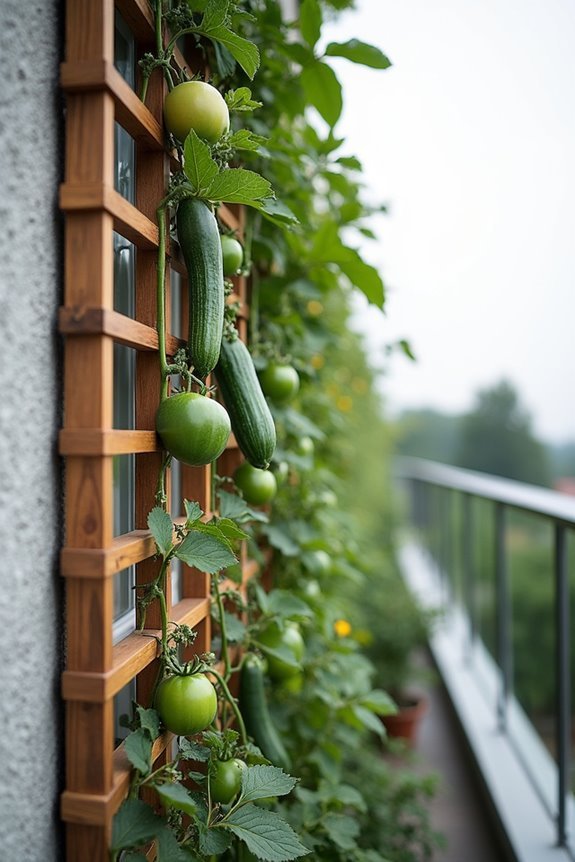
Because space is precious in small gardens, vertical trellises offer a brilliant solution for growing your favorite climbing vegetables. You’ll be amazed how cucumbers, peas, beans, and squash naturally reach for the sky when given proper support.
Choose from simple structures like bamboo teepees, metal grids, or repurposed ladders placed against sunny walls. For best results, set up your trellis before planting, ensuring it’s firmly anchored to withstand wind and the weight of growing produce.
Position your vegetables at the trellis base, gently training young stems to find their support. Some plants, like cucumbers, have natural tendrils that grab hold, while others, such as tomatoes, need gentle ties. You’ll love watching your garden grow upward instead of outward, giving you bountiful harvests in your limited outdoor space.
Shoe Organizer Vertical Gardens
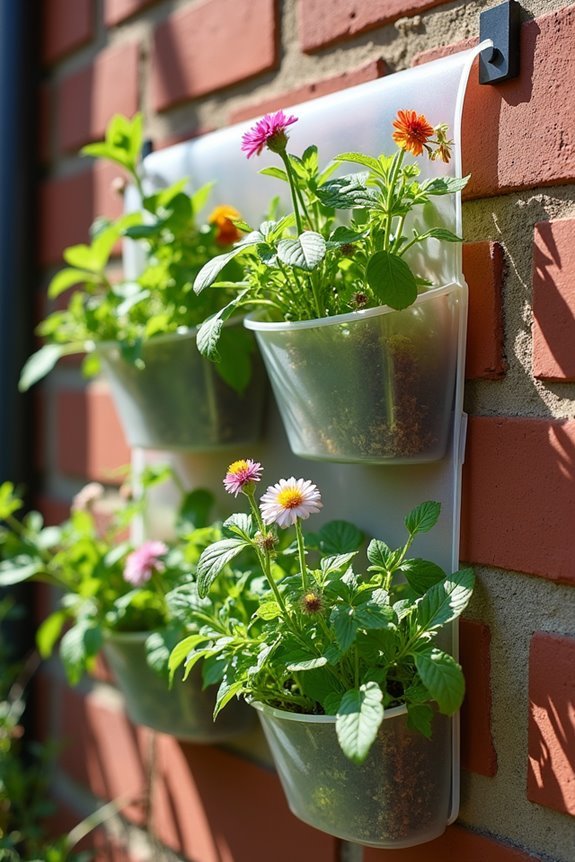
Although pocket shoe organizers were designed for closets, they’ve become one of the most ingenious vertical gardening solutions for tiny outdoor spaces. You’ll love how they transform your balcony, fence, or wall into a thriving garden with minimal effort.
To create your own shoe organizer garden, follow these simple steps:
- Choose a fabric organizer with sturdy pockets that can hold soil without sagging
- Line each pocket with landscape fabric for proper drainage
- Fill pockets with lightweight potting soil mixed with slow-release fertilizer
- Plant herbs, small vegetables, or flowers that don’t require deep root systems
The best part about shoe organizer gardens is their flexibility. You can easily move them to catch ideal sunlight, and they’re perfect for beginners who want to grow fresh herbs within arm’s reach of their cooking area.
Stackable Tiered Planters for Corner Spaces
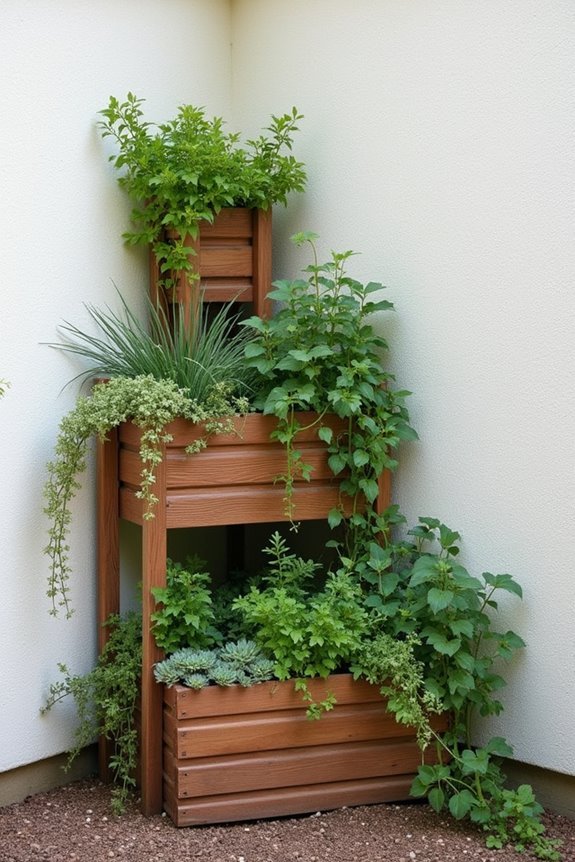
Three underutilized corners of your balcony or patio can transform into flourishing garden spaces with stackable tiered planters. These space-saving wonders feature multiple levels that fan out from the corner, creating a cascade of greenery that draws the eye upward instead of outward.
You’ll find many affordable options made from plastic, wood, or metal, each offering different aesthetic appeals. For beginners, start with herbs like basil, mint, and chives on the top tiers where you’ll reach them easily, then place trailing plants like ivy or strawberries on lower levels to create beautiful cascades.
The best part? Most tiered planters assemble without tools, so you’ll be gardening in minutes. When seasons change, simply move the entire structure to follow the sun or bring it indoors during harsh weather.
Fence-Mounted Flower Boxes
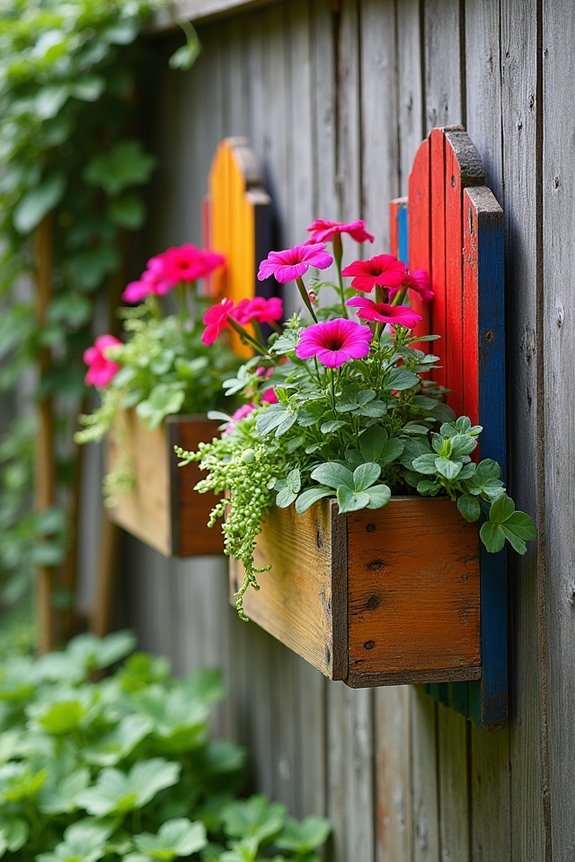
Every inch of your outdoor space becomes valuable real estate when you’re working with limited square footage. Fence-mounted flower boxes offer a brilliant solution, transforming bland boundaries into vibrant, living walls of color and texture. You’ll love how these versatile containers instantly brighten your outdoor sanctuary while preserving precious floor space.
Here’s how to make the most of your fence-mounted boxes:
- Choose lightweight containers with secure mounting brackets to prevent damage to your fence
- Install a simple drip irrigation system to make watering effortless, even for boxes mounted high
- Plant cascading flowers like petunias or ivy at the edges for a gorgeous waterfall effect
- Combine herbs, flowers, and small vegetables in the same box for both beauty and functionality
Living Picture Frames With Moss and Ferns
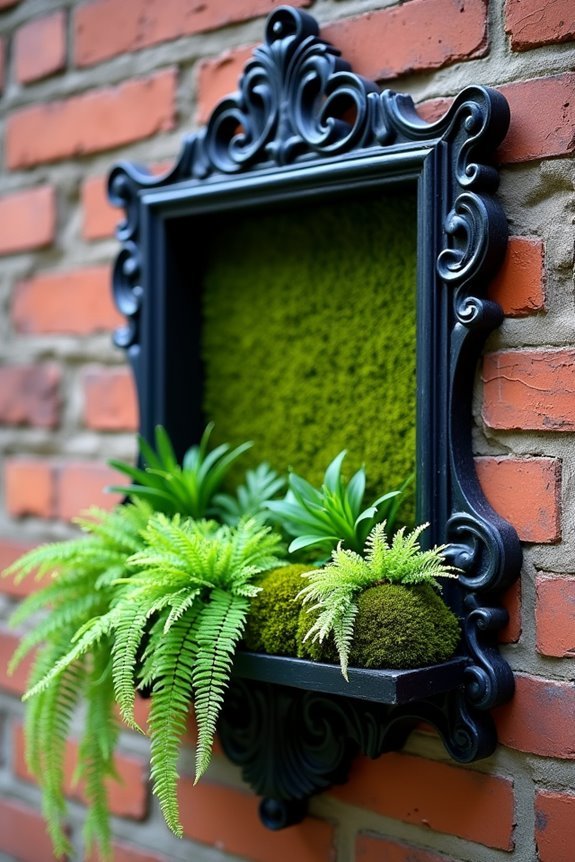
Living picture frames transform ordinary walls into enchanting works of natural art with their lush textures and verdant appeal. You’ll be amazed at how these miniature ecosystems bring life to your small outdoor space while taking up minimal room.
To create your own, start with a wooden shadow box frame, line it with landscape fabric, and fill it with moisture-retaining sphagnum moss. Select shade-loving ferns, small air plants, or cushiony moss varieties that thrive in vertical settings. The beauty is in the contrast of textures and shades of green.
You’ll need to mist your living artwork regularly, especially during warmer months. Place your frames where they’ll receive indirect light, like under eaves or on a shaded wall. For a striking display, hang three different-sized frames at varying heights.
Upcycled Ladder Plant Displays
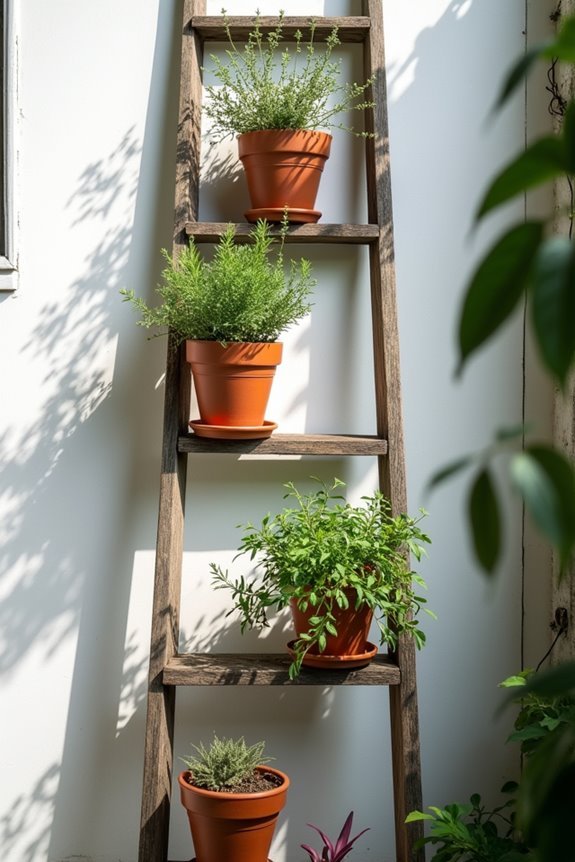
While living picture frames add vertical greenery to your walls, an old wooden ladder can transform into a stunning multi-tiered plant showcase. You’ll love how this charming alternative uses height without taking up precious floor space in your small outdoor area. The rustic look of weathered wood creates a beautiful contrast with vibrant greenery.
Here’s how to create your ladder display:
- Sand down rough edges and apply a weather-resistant finish to protect your ladder from outdoor elements
- Secure the ladder against a wall or fence, or set it at an angle for stability
- Place potted plants on each step, arranging larger ones at the bottom and smaller ones toward the top
- Add hanging planters from the rungs for additional dimension and interest
Window Box Vertical Arrangements
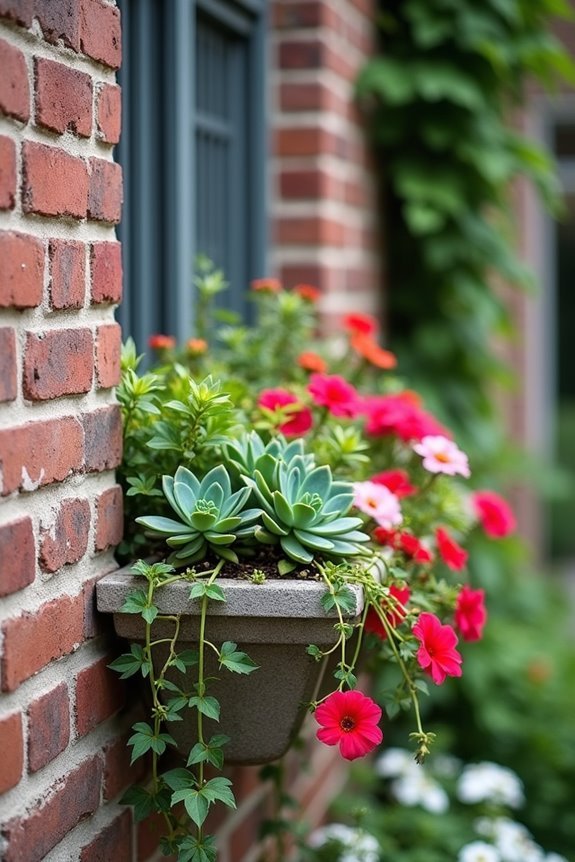
Traditional window boxes no longer need to be confined to your windowsills when you can stack them vertically to maximize your small outdoor space. You’ll create a stunning visual display while growing more plants in a fraction of the footprint!
| Position | Plant Ideas | Care Tips |
|---|---|---|
| Top Level | Trailing ivy, nasturtiums | Water less frequently (drains to boxes below) |
| Middle Level | Herbs, compact flowers | Check moisture twice weekly |
| Bottom Level | Shade-loving ferns, coleus | Guarantee proper drainage holes |
Consider mounting your window boxes on a fence, wall, or free-standing frame. You’ll want to secure them properly to prevent accidents. Don’t forget to choose boxes in complementary colors or materials that match your outdoor décor. Your vertical window box garden will bring joy every time you step outside!
Balcony Railing Hanging Gardens
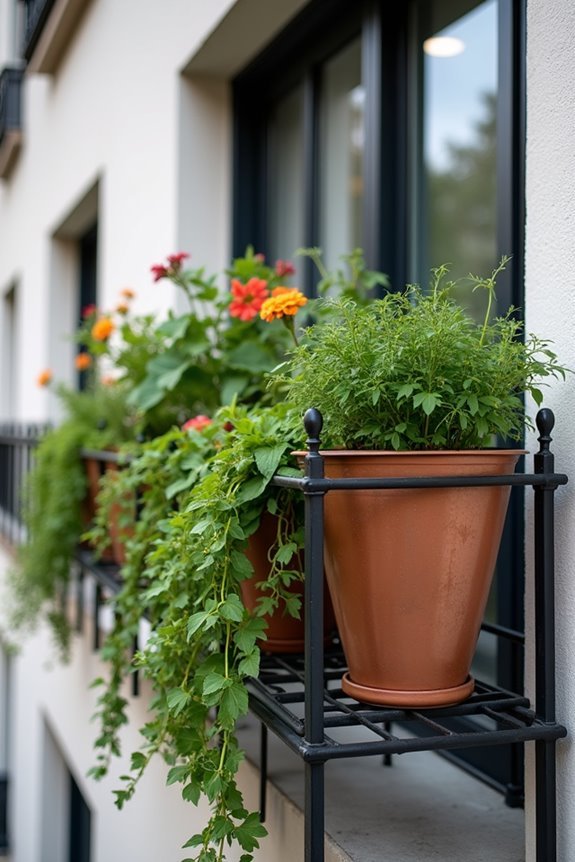
Balcony railings offer the perfect foundation for creating stunning vertical gardens without taking up precious floor space. You’ll love how these hanging gardens transform your outdoor area into a lush, green retreat that brings nature closer to you. With the right plants and containers, your balcony railing can become a beautiful living wall that you’ll enjoy every day!
Here are four fantastic options for your balcony railing garden:
- Colorful flower pouches that drape beautifully over railings
- Multiple-tiered hanging planters for herbs and small vegetables
- Railing-mounted boxes with brackets for stability and easy watering
- Vertical pocket planters made from recycled materials for an eco-friendly approach
Don’t worry if you’re new to gardening—these setups are surprisingly easy to maintain and will reward you with greenery year-round!
Self-Watering Bottle Gardens
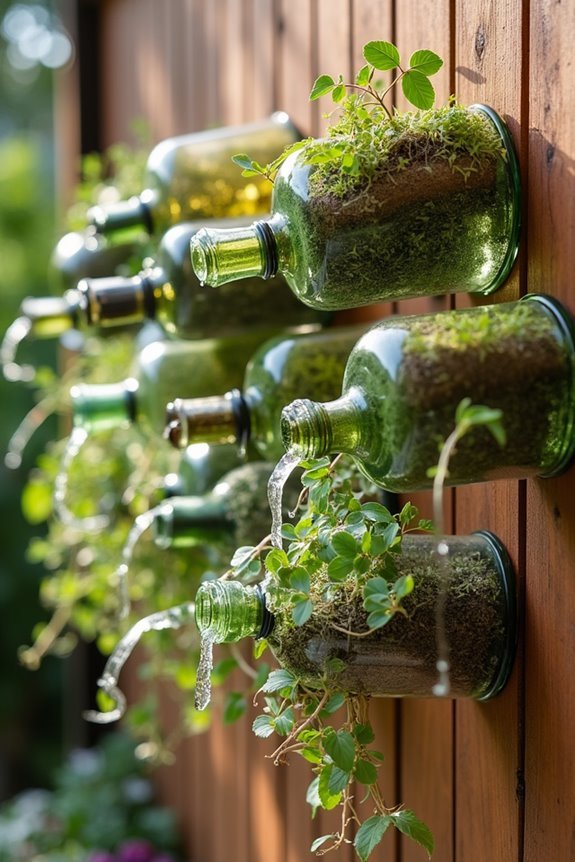
Several clever gardeners have discovered the magic of self-watering bottle gardens, a brilliant solution for busy plant lovers with limited outdoor space. You’ll love how these ingenious systems work, using recycled plastic bottles to create mini-ecosystems that water themselves for days at a time.
To create your own, simply cut a plastic bottle horizontally, invert the top portion to create a funnel, and fill it with soil. A piece of fabric, like cotton string or an old t-shirt strip, serves as the wick, drawing water up from the reservoir below to your plants’ roots. You can hang these bottles vertically using strong twine or wire, creating a stunning cascade of greenery that practically takes care of itself.
Vertical Hydroponic Systems for Leafy Greens
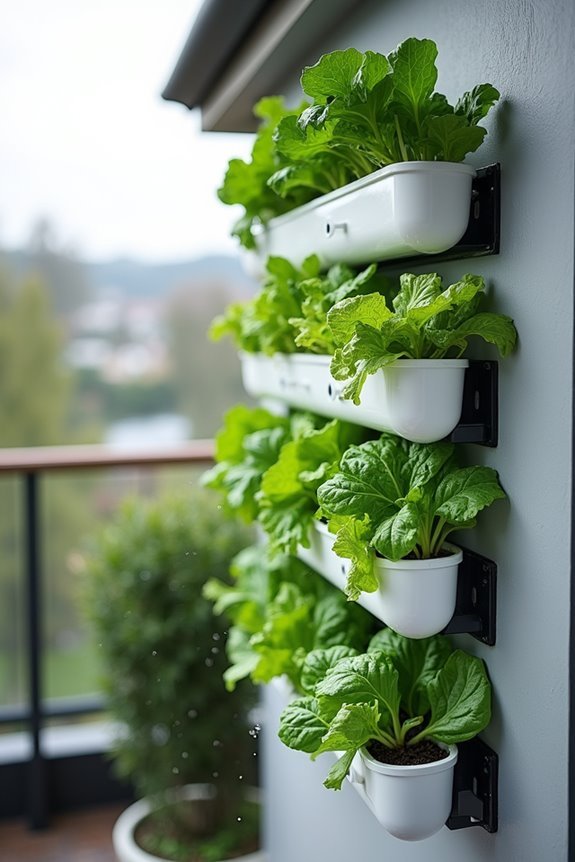
While traditional soil gardens require significant space, vertical hydroponic systems offer an incredible space-saving solution that’s perfect for growing leafy greens in even the tiniest outdoor areas. You’ll be amazed at how quickly your lettuce, spinach, and herbs grow without soil, using only nutrient-rich water and a fraction of the space!
Here’s what you’ll need to create your own vertical hydroponic garden:
- A vertical frame or tower system with planting pockets
- A small water pump and reservoir for circulation
- Hydroponic nutrients specifically formulated for leafy greens
- Seedling plugs or starter cubes for your favorite greens
Don’t worry if you’ve never tried hydroponics before—it’s much easier than you think! Your compact system will produce fresh, delicious greens year-round with minimal maintenance.
Magnetic Herb Containers for Metal Surfaces
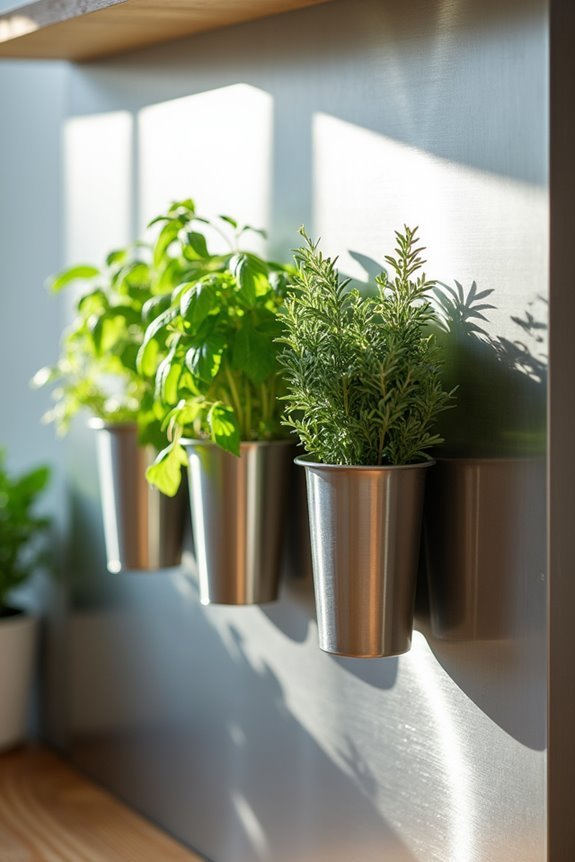
When you’re short on gardening space but still craving fresh herbs, magnetic herb containers offer an ingenious solution that transforms any metal surface into a vibrant, aromatic garden. These clever containers stick right to your refrigerator, metal backsplash, or any steel surface, keeping your favorite herbs within arm’s reach while saving precious counter space.
| Herb Type | Container Size | Watering Needs |
|---|---|---|
| Basil | Medium | Moderate |
| Mint | Small | Frequent |
| Rosemary | Large | Minimal |
You’ll love how these magnetic pots brighten up your kitchen with their practicality and charm. Simply fill them with quality potting soil, plant your favorite herb seeds or seedlings, and position them where they’ll get adequate sunlight. Remember to rotate them occasionally to guarantee even growth, and you’ll soon have fresh herbs at your fingertips!
Frequently Asked Questions
How Much Weight Can My Balcony or Wall Safely Support?
You’ll need to check your specific balcony’s weight capacity with your building manager or a structural engineer. Typically, residential balconies support 50-100 pounds per square foot, while walls vary based on construction. Don’t guess with this – it’s essential for your safety! Vertical gardens can add significant weight when soil is wet, so getting professional confirmation will give you peace of mind before hanging those beautiful plants.
What Plants Should I Avoid in Vertical Gardens?
Avoid invasive species like English ivy and kudzu for your vertical garden, as they can quickly take over. Skip plants with deep root systems, such as bamboo, which might damage your wall structure. You’ll want to steer clear of extremely heavy plants too, including large succulents and trees, that could overburden your support system. Finally, don’t choose plants that need frequent pruning, as they’ll be hard to maintain in a vertical setting.
How Do Vertical Gardens Affect Building Walls Over Time?
Like an uninvited guest that overstays its welcome, vertical gardens can damage walls over time. You’ll notice moisture issues if you don’t install proper barriers, which can lead to mold and rot. Plant roots might penetrate cracks, weakening your structure. However, with waterproof membranes, root barriers, and air gaps between plants and walls, you can protect your home while enjoying your green oasis. Regular checks for damage will keep your walls safe.
Can Vertical Gardens Attract Pests to My Home?
Yes, vertical gardens can attract pests to your home. Moist soil and dense foliage create perfect hiding spots for insects, snails, and sometimes rodents. You’ll want to check your plants regularly for signs of infestation, like chewed leaves or sticky residue. Don’t worry though! Healthy gardens often attract beneficial insects too, creating a natural balance. Using proper drainage, airflow, and occasional organic pest control will help you keep unwanted visitors at bay.
What’s the Typical Lifespan of Different Vertical Gardening Systems?
The lifespan of your vertical gardening system depends on its materials. Plastic systems typically last 5-7 years, while wooden structures survive 7-10 years with proper sealing. Metal systems are champions, lasting 15+ years if you protect them from rust. Fabric pocket gardens need replacement every 2-3 years. You’ll get the most longevity when you maintain your system regularly, checking for damage and renewing soil annually.
